自考语言学Chapter5
语言学Chapters 5
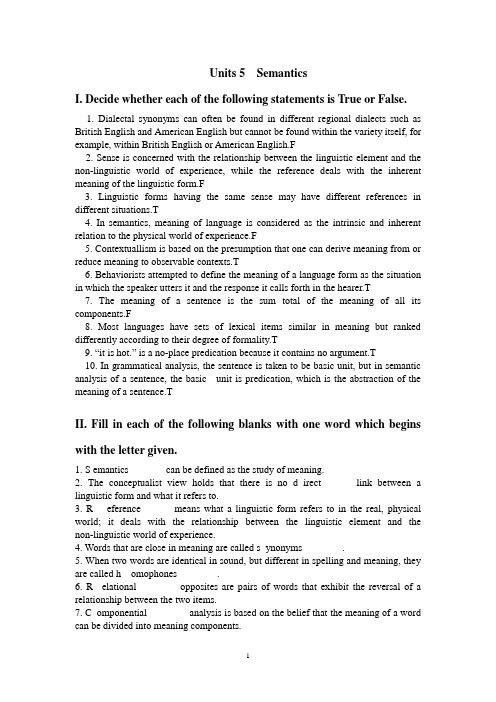
Units 5 SemanticsI. Decide whether each of the following statements is True or False.1. Dialectal synonyms can often be found in different regional dialects such as British English and American English but cannot be found within the variety itself, for example, within British English or American English.F2. Sense is concerned with the relationship between the linguistic element and the non-linguistic world of experience, while the reference deals with the inherent meaning of the linguistic form.F3. Linguistic forms having the same sense may have different references in different situations.T4. In semantics, meaning of language is considered as the intrinsic and inherent relation to the physical world of experience.F5. Contextuallism is based on the presumption that one can derive meaning from or reduce meaning to observable contexts.T6. Behaviorists attempted to define the meaning of a language form as the situation in which the speaker utters it and the response it calls forth in the hearer.T7. The meaning of a sentence is the sum total of the meaning of all its components.F8. Most languages have sets of lexical items similar in meaning but ranked differently according to their degree of formality.T9. “it is hot.” is a no-place predication because it contains no argument.T10. In grammatical analysis, the sentence is taken to be basic unit, but in semantic analysis of a sentence, the basic unit is predication, which is the abstraction of the meaning of a sentence.TII. Fill in each of the following blanks with one word which begins with the letter given.1. S emantics_______ can be defined as the study of meaning.2. The conceptualist view holds that there is no d_irect______ link between a linguistic form and what it refers to.3. R __eference______ means what a linguistic form refers to in the real, physical world; it deals with the relationship between the linguistic element and the non-linguistic world of experience.4. Words that are close in meaning are called s_ynonyms________.5. When two words are identical in sound, but different in spelling and meaning, they are called h__omophones________.6. R _elational________ opposites are pairs of words that exhibit the reversal of a relationship between the two items.7. C_omponential________ analysis is based on the belief that the meaning of a word can be divided into meaning components.8. Whether a sentence is semantically meaningful is governed by rules called s_electional______ restrictions, which are constrains on what lexical items can go with what others.9. An a _rgument_______ is a logical participant in a predication, largely identical with the nominal element(s) in a sentence.10. According to the n_aming_________ theory of meaning, the words in a language are taken to be labels of the objects they stand for.III. Multiple Choice1. Which of the following is NOT the concern of “sense”?BA. It is the study of the inherent meaning of the linguistic form.B. It is the study of what a linguistic form refers to in the real physical world.C. It is the aspect of meaning dictionary compliers are interested in.D. It is the collection of all the features of the linguistic form.2. The meaning relationship between the two words “sheep”and “ewe”is __C______.A. AntonymyB. HomonymyC. HyponymyD. Polysemy3. X: They are going to have another baby.Y: They have a child.The relationship of X and Y is ___D__________.A. synonymousB. inconsistentC. X entailing YD. X presupposing Y4. According to the componential analysis, the words “girl” and “woman” differ in the feature of _______D_____.A. HUMANB. ANIMATEC. MALED. ADULT5. According to predication analysis, the predication of the sentence “It is hot.” is a _____A____.A. no-place predicationB. one-place predicationC. two-place predicationD. three-place predication6. The relationship between “voilet” and “tulip” is _A_______.A. co-hyponymsB. superordinateC. hyponymsD. antonyms7. The relationship between “begin” and “commence” is _B_________.A. Dialectal synonymsB. Stylistic synonymsC. Collocational synonymsD. Semantically different synonyms8. Predication analysis is a way to analyze __D____ meaning.A. phonemeB. wordC. phraseD. sentence9. What is the relationship between the words “color” and “red”? DA. SynonymyB. AntonymyC. PolysemyD. Hyponymy.10. “Fall” and “autumn” are ____A_____ synonyms.A. dialectalB. stylisticC. evaluatively differentD. semantically different11. The four major modes of semantic change are __A______.A. extension, narrowing, elevation and degradationB. extension, generalization, elevation and degradationC. extension, narrowing, specialization and degradationD. extension, elevation, amelioration and degradation12. The semantic features of the word “girl” can be expressed as ___D___.A. + animate, -human, + adult, + male.B. + animate, + human, -adult, + male.C. +animate, + human, + adult, -male.D. + animate, + human, -adult, -male.13. What is the sentential relation between “He likes skating.” And “ He likes sports.”? BA. Presupposition.B. Entailment.C. Contradiction.D. Hyponymy.14. The pair of words “borrow/lend” is called _A______.A. relational oppositeB. synonymsC. complementaryD. gradable opposites15. “Yellow”has different meanings to Chinese or to western people, that is its ____C_____.A. conceptual meaningB. cognitive meaningC. associative meaningD. stylistic meaning16. X: He has been to France.Y: He has been to Europe.The relationship of X and Y is ___C________.A. synonymousB. insonsistentC. X entailing YD. X presupposing Y17. The ambiguity in “ pass the port” is caused by ___D________.A. lexical itemsB. a grammatical structureC. homonymyD. polysemy18. Componential analysis is a method in the field of ____C___.A. phoneticsB. syntaxC. semanticsD. pragmatics19. “ Big” and “small” are a pair of __B____ opposites.A. complementaryB. gradableC. completeD. converse20. We call the relation between “ animal” and “ horse” as ___D____.A. synonymyB. polysemyC. homonymyD. hyponymy21. The word “pen”originally meant “feather used for writing with ink”. Now it refers to any devise used for writing with ink. This is an example of B________.A. degradation of meaningB. broadening of meaningC. narrowing of meaningD. elevation of meaning22. “ Buy” and “sell” form a pair of ____A______.A. converse antonymsB. gradable antonymsC. complementary antonymsD. marked antonyms23. For Bloomfield, linguistics is a branch of psychology and specifically of the brand of psychology known as ______A____.A. behaviorismB. structuralismC. competenceD. performance24. _____B____ deals with the relationship between the linguistic element and non-linguistic world of experience.A. SenseB. ReferenceC. SymbolD. Thought25. Knight originally meant youth, but now it means a medieval gentlemen soldier. BA. broadeningB. narrowingC. meaning shiftD. class shift26. The classic semantic triangle or triangle of significance mainly illustrates the view of __A________.A. conceptualismB. contextualismC. behaviorismD. structuralism27. The words “rain” and “reign” are _____C______.A. homographsB. complete homonymsC. homophonesD. allophones28. Sense and reference are two terms often encountered in the study of ____B____.A. word functionB. word meaningC. word formationD. word system29. _A______ is the major concern of semantics.A. MeaningB. wordsC. Sentence structuresD. Phrase structure rules30. The contexualist view of meaning is based on the presumption that one can derive meaning from _______B____.A. functionB. contextC. instinctD. observation31. The naming theory is advanced by _____A_______.A. PlatoB. BloomfieldC. Geoffrey LeechD. Firth32. “We shall know a word by the company it keeps.”This statement represents _______B______.A. the conceptualist viewB. contexutalismC. the naming theoryD. behaviorism33. Which of the following is NOT true? DA. Sense is concerned with the inherent meaning of the linguistic form.B. Sense is the collection of all the features of the linguistic form.C. Sense is abstract and de-contextualized.D. Sense is the aspect of meaning dictionary compliers are not interested in.34. X: Can I borrow your bike?Y: You have a bike.The relationship between X and Y is that _________D__.A. X is synonymous with YB. X is inconsistent with YC. X entails YD. X presupposes Y35. ____B_____ is a way in which the meaning of a word can be dissected into meaning components, called semantic features.A. Predication analysisB. Componential analysisC. Phonemic analysisD. Grammatical analysis36. “ alive” and “dead” are ____C________.A. gradable antonymsB. relational oppositesC. complementary antonymsD. None of the above37. __C________refers to the phenomenon that words having different meanings have the same form.A. PolysemyB. SynonymyC. HomonymyD. Hyponymy38. Words that are close in meaning are called _____D_____.A. homonymsB. polysemyC. hyponymsD. synonyms39. The grammaticality of a sentence is governed by _____A_______.A. grammatical rulesB. selectional restrictionsC. semantic rulesD. semantic features40. What essentially distinguishes semantics and pragmatics is the notion of__D__________.A. referenceB. meaningC. antonymyD. contextIV. Define the following terms1. semantics2. sense3. reference4. synonymy5. homonymy6. homographs7. hyponymy8. antonymy9. componential analysis10. argumentV. Answer the following questions1. Why do we say that a meaning of a sentence is not the sum total of the meanings of all its components?2. What is componential analysis? Illustrate it with examples.3. How do you distinguish between entailment and presupposition in terms of truth values?4. How do you account for such sense relations between sentences as synonymousrelation, inconsistent relation in terms of truth values?5. What are the major views concerning the study of meaning? How they differ?I. 1-5 FFTFT 6-10 TFTTTII. 1. Semantics 2. Direct 3. reference 4. synonyms 5. homophones 6. relational 7. Componential 8. selectional 9. argument 10 namingII. 1---5 BCDDA 6-10 ABDDA 11-15 ADBAC 16-20 CDCBD21-25 BAABB 26-30 ACBAB 31-35 ABDDB 36-40 CCDAD。
chapter5semantics语言学
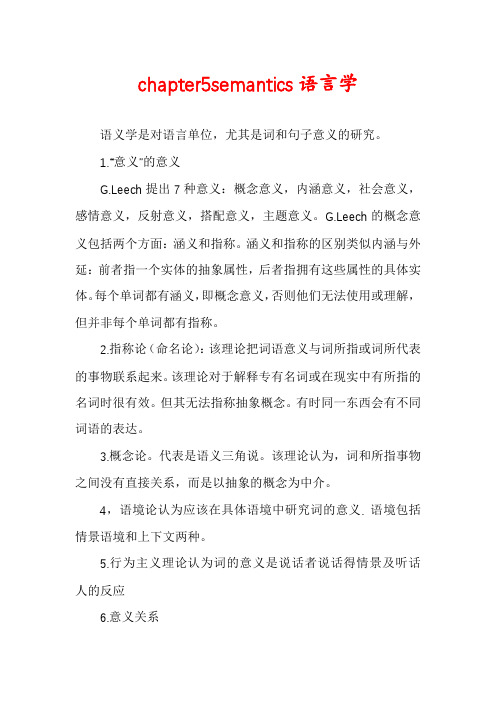
chapter5semantics语言学语义学是对语言单位,尤其是词和句子意义的研究。
1.“意义”的意义G.Leech提出7种意义:概念意义,内涵意义,社会意义,感情意义,反射意义,搭配意义,主题意义。
G.Leech的概念意义包括两个方面:涵义和指称。
涵义和指称的区别类似内涵与外延:前者指一个实体的抽象属性,后者指拥有这些属性的具体实体。
每个单词都有涵义,即概念意义,否则他们无法使用或理解,但并非每个单词都有指称。
2.指称论(命名论):该理论把词语意义与词所指或词所代表的事物联系起来。
该理论对于解释专有名词或在现实中有所指的名词时很有效。
但其无法指称抽象概念。
有时同一东西会有不同词语的表达。
3.概念论。
代表是语义三角说。
该理论认为,词和所指事物之间没有直接关系,而是以抽象的概念为中介。
4,语境论认为应该在具体语境中研究词的意义. 语境包括情景语境和上下文两种。
5.行为主义理论认为词的意义是说话者说话得情景及听话人的反应6.意义关系词语词之间的主要意义关系:相同关系,相反关系,包含关系a.同义关系。
完全同义关系很少,所谓的同一都依赖语境,并总在某方面不同。
(方言,内涵,文体等)b.反义关系主要包括:等级反义关系,互补反义关系,关系反义关系。
1)等级反义的特点:第一,否定一方并不必然是肯定另一方,还有中间状态;第二,没有绝对评判标准,标准随对象而改变。
第三,通常用其中表示较高程度的词来覆盖整个量级。
覆盖性词被称为“无标记的”,即一般性的;被覆盖词被称为“有标记的”,即特殊的。
一般使用覆盖性词语。
一旦使用被覆盖词语,表示有某种特殊的、不一般的情况。
第四,可用very修饰,可有比较级最高级2)互补反义关系,第一,肯定一方意味着否定另一方。
反之亦然。
第二,不用very修饰,没有比较级最高级。
第三,评判标准绝对。
没有覆盖性词语3)关系(反向)反义关系,表现两个实体间的一种反向关系,不构成肯否定对立。
一个预设着另一个的存在。
语言学整理的资料Chapter 5 semantics
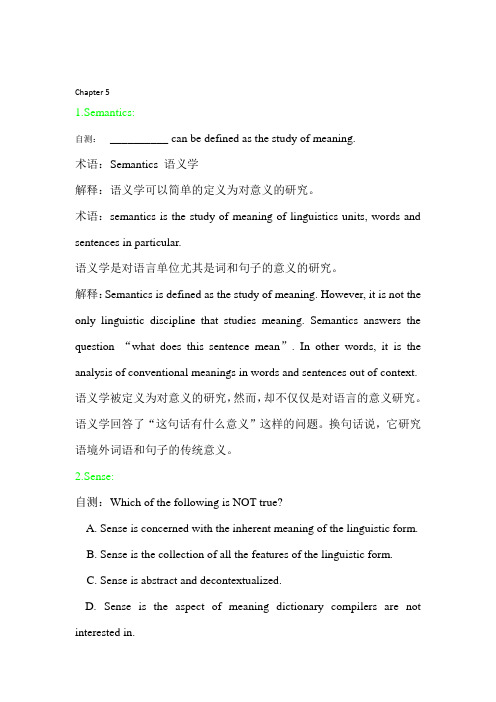
Chapter 51.Semantics:自测: __________ can be defined as the study of meaning.术语:Semantics 语义学解释:语义学可以简单的定义为对意义的研究。
术语:semantics is the study of meaning of linguistics units, words and sentences in particular.语义学是对语言单位尤其是词和句子的意义的研究。
解释:Semantics is defined as the study of meaning. However, it is not the only linguistic discipline that studies meaning. Semantics answers the question “what does this sentence mean”. In other words, it is the analysis of conventional meanings in words and sentences out of context. 语义学被定义为对意义的研究,然而,却不仅仅是对语言的意义研究。
语义学回答了“这句话有什么意义”这样的问题。
换句话说,它研究语境外词语和句子的传统意义。
2.Sense:自测:Which of the following is NOT true?A. Sense is concerned with the inherent meaning of the linguistic form.B. Sense is the collection of all the features of the linguistic form.C. Sense is abstract and decontextualized.D. Sense is the aspect of meaning dictionary compilers are not interested in.术语:Sense 涵义解释:涵义指一个实体的抽象属性。
语言学chapter5Grammar
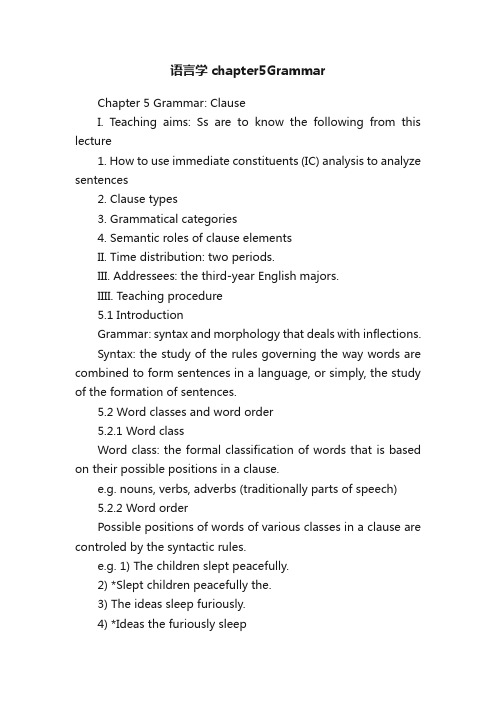
语言学chapter5GrammarChapter 5 Grammar: ClauseI. Teaching aims: Ss are to know the following from this lecture1. How to use immediate constituents (IC) analysis to analyze sentences2. Clause types3. Grammatical categories4. Semantic roles of clause elementsII. Time distribution: two periods.III. Addressees: the third-year English majors.IIII. Teaching procedure5.1 IntroductionGrammar: syntax and morphology that deals with inflections.Syntax: the study of the rules governing the way words are combined to form sentences in a language, or simply, the study of the formation of sentences.5.2 Word classes and word order5.2.1 Word classWord class: the formal classification of words that is based on their possible positions in a clause.e.g. nouns, verbs, adverbs (traditionally parts of speech)5.2.2 Word orderPossible positions of words of various classes in a clause are controled by the syntactic rules.e.g. 1) The children slept peacefully.2) *Slept children peacefully the.3) The ideas sleep furiously.4) *Ideas the furiously sleepImmediate constituents (IC) analysis: the analysis of a sentence in terms of its immediate constituents---word groups (phrases), which are in turn analyzed into the immediate constituents of their own, and the process goes on until the ultimate constituents are reached. It may be carried out with brackets or vertical bars and shown with tree diagrams.5.3 Clause typesFunctional categories:OBJECTS (O): DIRECT OBJECT (Od)INDIRECT OBJECT (Oi)COMPLEMENT (C):SUBJECT COMPLEMENT(Cs)OBJECT COMPLEMENT (Co)ADVERBIALS (A):SUBJECT-RELATED ADVERBIAL (As)OBJECTED-RELATED ADVERBIAL (Ao)A clause usually belongs to one of the seven major types:SV, SVO, SVCs,SV As, SVOiOd,SVOC, SVOAo.1)The sun is shining. (SV)2)The film bored her. (SVO)3)The house looks nice. (SVCs)4)My room is on the second floor. (SV As)5)His father gives him a birthday gift. (SVOiOd)6)The girl painted the box blue. (SVOCo)7)Your brother put your book on the shelf. (SVOAo)5.4 Grammatical categoriesFor nouns and adjectives:Number◆The English verb also inflects for number, e.g. He speaksEnglish. Inlanguages like French, adjectives and articles have numbers too.◆Two terms of number: singular and plural. Some languages like classicalGreek and Arabic have a third number: dual(双数), which means “both”. And Fijian(斐济语)has a fourth: trial(三数). Chinese is said to have none. 们limited usageGenderGender(性)is also mostly a category of the noun and pronoun. In English the gender distinctions are on the whole natural, determined by the biological gender of the creature, e.g. actor, actress; hero, heroine. In some languages like French the gender distinctions are grammatical. They may have nothing to do with the sex of the real world entities at all. And all nouns have gender distinctions whether they refer to animate entities or not.CaseCase(格) is prominent in the grammar of Latin. It has six distinctions of nominative(主格), vocative(呼格), accusative(宾格), genitive(属格), dative(与格)and ablative(离格). In English, pronouns have three cases of nominative(I, he, she), accusative(me, him, her) and genitive(my, your, his). Nouns have two cases: general(普通格)and genitive(John’s, boy’s).For verbs:Tense: it is deictic(指别的), which indicates time relative to the time of utterance. Aspect: it is not deictic, the time indicated is not relative to the time of utterance, but relative to the time of another event described in the narrative.MoodMood involves a choice between indicative, imperative,subjective forms of the verb.e.g. He is quiet. (indicative)Be quiet. (imperative)I demanded that he be quiet. (subjective)5.5 Half-clauseHalf-clauses are not complete in that the verbs in them do not have tense, mood, person and number differences.Half-clause: nonfinite clause and verbless clauseNonfinite clause1. To-infinitivee.g. It’s all right for me to be here.2. Bare infinitivee.g. Rather than you do the job, I’d prefer to leave it undone.3. -ing participlee.g. My son having left for school, I sat down at the computer to work.4. -ed participlee.g. The project completed, the team moved to another construction site.Verbless clauseVerbless clauses don’t have verbs of any forms and they are more compressed than nonfinite clauses.e.g. Too nervous on the stage, I forgot all I was supposed to say.5.6 Semantic rolesAgent: the animate doer of the actione.g. The terrorist killed the minister.Patient: the participant who is directly affected by the action.e.g. The terrorist was killed.Recipient or beneficiary: the participant who benefits fromthe action.e.g. The terrorist had a gun.Experiencer: the animate participant who experiences a mental state or process.e.g. The terrorist liked guns.。
英语语言学概论 Chapter 5 Morphology(形态学)
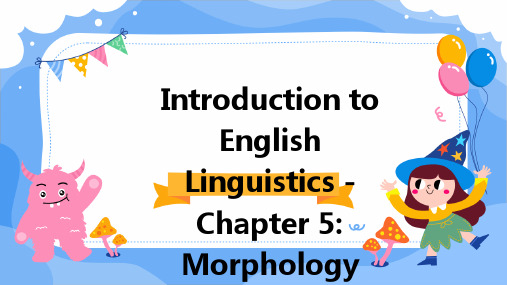
"basketball" (combination of "basket" and "ball")
"mother-in-law" (combination of "mother" and "in-law")
"blackboard" (combination of "black" and "board")
• Inflectional Variation: Morphology also deals with the inflectional variation of words, which refers to the changes in word form that indicate grammatical function or category. Understanding inflectional morphology is crucial for proper sentence structure and grammar.
Grammar
目录
• The Relationship between Morphology and Vocabulary
01
Morphological Overview
Definition and Purpose
Definition: Morphology is the study of the structure and forms of words in a language. It focuses on the internal composition of words, including the derivation of new words from existing words (derivational morphology) and the modification of words through the addition or deletion of affixes (inflectional morphology).
语言学 第5章练习
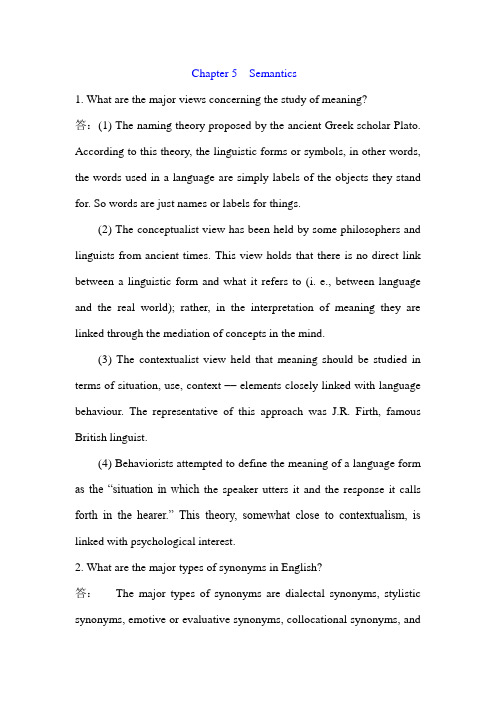
Chapter 5 Semantics1. What are the major views concerning the study of meaning?答:(1) The naming theory proposed by the ancient Greek scholar Plato. According to this theory, the linguistic forms or symbols, in other words, the words used in a language are simply labels of the objects they stand for. So words are just names or labels for things.(2) The conceptualist view has been held by some philosophers and linguists from ancient times. This view holds that there is no direct link between a linguistic form and what it refers to (i. e., between language and the real world); rather, in the interpretation of meaning they are linked through the mediation of concepts in the mind.(3) The contextualist view held that meaning should be studied in terms of situation, use, context –– elements closely linked with language behaviour. The representative of this approach was J.R. Firth, famous British linguist.(4) Behaviorists attempted to define the meaning of a language form as the “situation in which the speaker utters it and the response it calls forth in the hearer.” This theory, somewhat close to contextualism, is linked with psychological interest.2. What are the major types of synonyms in English?答:The major types of synonyms are dialectal synonyms, stylistic synonyms, emotive or evaluative synonyms, collocational synonyms, andsemantically different synonyms.Examples(略)3. Explain with examples “homonymy”, “polysemy”, and “hyponymy”.答:(1) Homonymy refers to the phenomenon that words having different meanings have the same form, i.e., different words are identical in sound or spelling, or in both.When two words are identical in sound, they are homophones.When two words are identical in spelling, they are homographs. When two words are identical in both sound and spelling, they are complete homonyms(2) While different words may have the same or similar meaning, the same one word may have more than one meaning. This is what we call polysemy, and such a word is called a polysemic word. There are many polysemic words in English, The fact is the more commonly used a word is, the more likely it has acquired more than one meaning.(3) Hyponymy refers to the sense relation between a more general, more inclusive word and a more specific word. The word which is more general in meaning is called the superordinate, and the more specific words are called its hyponyms. Hyponyms of the same superordinate are co-hyponyms to each other. Hyponymy is a relation of inclusion; in terms of meaning, the superordinate includes all its hyponyms.Examples(略)4. How can words opposite in meaning be classified? To which category does each of the following pairs of antonyms belong?north/south vacant/occupied literate/illiterate above/below doctor/patient wide/narrow poor/rich father/daughter答:They can be gradable antonyms, complementary antonyms and relational oppositeGradable antonyms: wide /narrow poor/richComplementary antonyms: vacant/occupied literate/illiterateRelational opposite: north/south, doctor/patient, father/daughter, above/below5. Identify the relations between the following pairs of sentences:Tom's wife is pregnant. My sister will soon be divorced'Tom has a wife. My sister is a married woman.He likes seafood, They are going to have another baby.He likes crabs. They have a child.答:“Tom's wife is pregnant”presupposes “Tom has a wife.”“My sister will soon be divorced” presupposes “My sister is a married woman.”“He likes seafood” is entailed by “He likes crabs.”“They are going to have another baby” presupposes “They have a child.”6. In what way is componential analysis similar to the analysis ofphonemes into distinctive features?答:They both base on the belief that the meaning of a word can be dissected into meaning components.7. What is grammaticality? What might make a grammatically meaningful sentence semantically meaningless?答:Grammaticality refers to the grammatical well-formedness of a sentence. The violation of the selectional restrictions, i.e., constrains on what lexical items can go with what others, might make a grammatically meaningless.8. Try to analyze the following sentences in terms of predication analysis:The man sells ice-cream. Is the baby sleeping?It is snowing. The tree grows well.答:The man sells ice-cream.MAN, ICE-CREAM (SELL)Is the baby sleeping?BABY (SLEEP)It is snowing.(SNOW)The tree grows well.TREE (GROW)。
语言学Chapter 5 Meaning (revised)
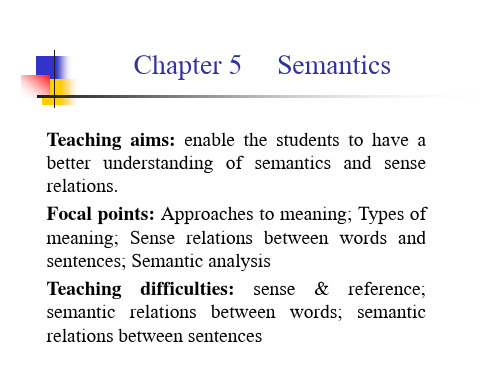
Q3: Types of meaning
3.1 Sense & reference 涵义和指称、系统意 义和外指意义 Sense-----the inherent meaning of the linguistic form independent of situational context. It’s the aspect of meaning dictionary compilers are interested in. It is concerned with the intra-linguistic relations. It’s abstract and de-contextualized.
பைடு நூலகம்
The term semantics is a recent addition to the English language. It has only a history of a little over a hundred years. 1894 it was introduced in a paper entitled “Reflected meanings:a point in semantics” 1897 Breal first used it as the science of meaning. 1900 its English version came out 1980s semantics began to be introduced into China One of the most famous books on semantics is The Meaning of Meaning published in 1923.
英语语言学概论第五章笔记
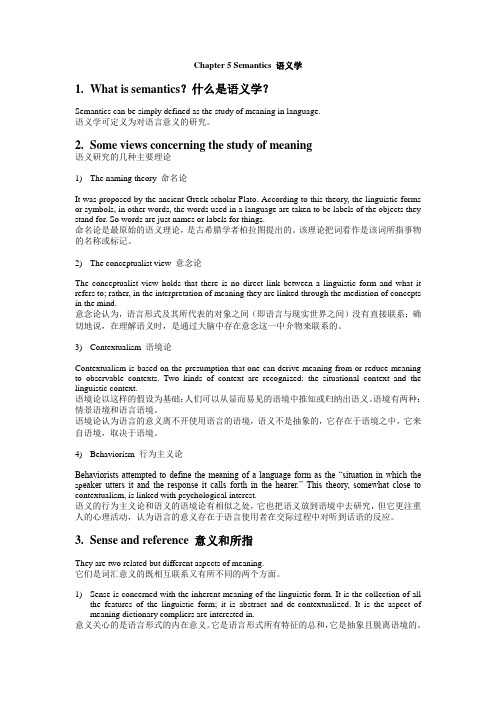
Chapter 5 Semantics 语义学1.What is semantics?什么是语义学?Semantics can be simply defined as the study of meaning in language.语义学可定义为对语言意义的研究。
2.Some views concerning the study of meaning语义研究的几种主要理论1)The naming theory 命名论It was proposed by the ancient Greek scholar Plato. According to this theory, the linguistic forms or symbols, in other words, the words used in a language are taken to be labels of the objects they stand for. So words are just names or labels for things.命名论是最原始的语义理论,是古希腊学者柏拉图提出的。
该理论把词看作是该词所指事物的名称或标记。
2)The conceptualist view 意念论The conceptualist view holds that there is no direct link between a linguistic form and what it refers to; rather, in the interpretation of meaning they are linked through the mediation of concepts in the mind.意念论认为,语言形式及其所代表的对象之间(即语言与现实世界之间)没有直接联系;确切地说,在理解语义时,是通过大脑中存在意念这一中介物来联系的。
语言学Chapter 5
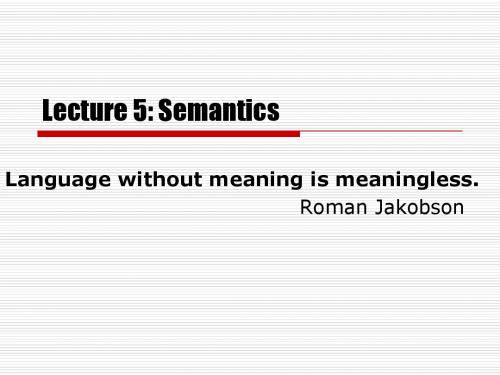
Collocative meaning搭配意义
It refers to the associations a word acquires on account of its mutual expectancy with some other words which tend to occur in its environment. Example: pretty and handsome pretty {girl, boy, woman, flower, etc.} handsome {boy, man, car, vessel, etc.} cows may wander, but may not stroll. one trembles with fear, but quiver with excitement.
Social/stylistic meaning社会/文体意 义
It refers to what language conveys about the social circumstances of its use. It relates to people’s recognition of different dimensions and levels of style with the same language steed (poetic) residence (formal) horse (general) abode (poetic) nag (slang) home (general) gee-gee (baby language) domicile (very formal, official)
thereferentialtheory?古希腊哲学家柏拉图认为语言形式是语言中的一个词语义是它所代表所指示所表示的世界上的实体指称referent
27037 本科自考英语语言学概论精心整理 Chapter 5 Morphology(word文档良心出品)

Chapter 5 Morphology(形态学,词法学)5.1 what is morphology?什么是形态学?Morphology is one of subbranches of linguistics,and also a branch of grammar.形态学即使语言学的分支,也是语法的分支。
Morphology studies the internal structure of words,and the rules by which words are formed.形态学研究词的内部结构和构词规则。
可分为两个分支:inflectional morphology and lexical/derivational morphology屈折形态学和词汇或派生形态学5.2 morphemes (词素,语素)最简单的定义Morpheme is a minimal meaningful grammatical unit.语素是最小的有意义的语法单位。
Morphemes are the smallest meaningful units in the grammatical system of a language.语素是在语音的语法系统中最小的意义单位。
1 minimal: smallest,it can not further be divided.2 meaningful: can not be further divided without destroying its meaning3 grammatical: not only lexical morphemes like ,but also grammatical ones,5.3 Classification of morphemes 语素的分类Semantically:morphemes :root morphemes and affixational morphemes根据语义,语素可分为词根和词缀Structurally:morphemes :free morphemes and bound morphemes根据结构,语素可分为自由语素和粘着语素5.3.1 interrelations between free morphemes,bound morphemes,roots and affixes自由语素、粘着语素、词根和词缀的相互关系1)Free morphemes are those which can exist as individual words.eg.book,store.自由语素是那些独立存在的单词。
语言学笔记5说课材料

Chapter 5 Semantics一、定义1.命名论The naming theoryThe naming theory, one of the oldest notions concerning meaning, and also a very primitive onewas proposed by the ancient Greek scholar Plato. According to this theory, the linguistic forms orsymbols, in other words,the words used in a language are taken to be labels of the objects theystand for, so words are just names or labels for things.2.意念论The conceptualist viewIt holds that there is no direct link between a linguistic form and what it refers to; rather ,in theinterpretation of meaning they are linked through the mediation of concepts in the mind.3.语境论ConceptualismIt’s based on the presumption that one can derive meaning from or reduce meaning toobservable contexts. her are two kinds of context: the situational and the linguistic context.4.行为主义论BehaviorismIt refers to the attempted to define the meaning of a language form as the” situation in whicthis theory somewhat close tospeaker utters it and the response it calls forth in the hearer”.conceptualism emphasizes on the psychological response.5.意义Sensethe collection of all the concerned with the inherent meaning of the linguistic form. It’sIt’s-contextualized.features of the linguistic form, it’s abstract and de6.所指意义ReferenceIt means what a linguistic form refers to in the real, physical world, it deals with the relationshipbetween the linguistic element and the non-linguistic world of experience.7.同义词SynonymyIt refers to the sameness or close similarity of meaning or we can say that words are close inmeaning are called synonyms.8.多义词PolysemyIt refers to different words may have the same or similar meaning, the same one word may havemore than one meaning.9.同音(形)异义HomonymyIt refers to the phenomenon that words have different meanings have the same form, i.e,different words are identical in sound or spelling, or in both.10.同音异义HomophonesIt refers to two words are identical in sound. e.g. rain/reign.11.同形异义HomographsIt refers to two words are identical in form .e.g. tear v./tear n.12.上下义关系HyponymyIt refers to the sense relation between a more general, more inclusive word and a more specificword. the word which is more general in meaning is called superordinate, and the more specificwords are called its hyponyms.13.反义词AntonymyIt’s the term used for oppositeness of meaning on different dimension.14.成分分析法Componential Analysis----分析词汇抽象意义It’s a way proposed by the structural semanticists to analyz e word meaning.this approach is based upon the belief that meaning of a word can be dissected into meaning components, called semantic features.15.述谓结构分析Predication Analysis 由British Linguist G.Leech提出analysis.It’s a new approach for sentential meaningPredication is usually considered an important common category shared by propositions, questions, commands ect.通过对论元argument和谓语predicate的分析,达到对句子意义进行分析的许多模式中的一种。
自考语言学概论章节考试重点五
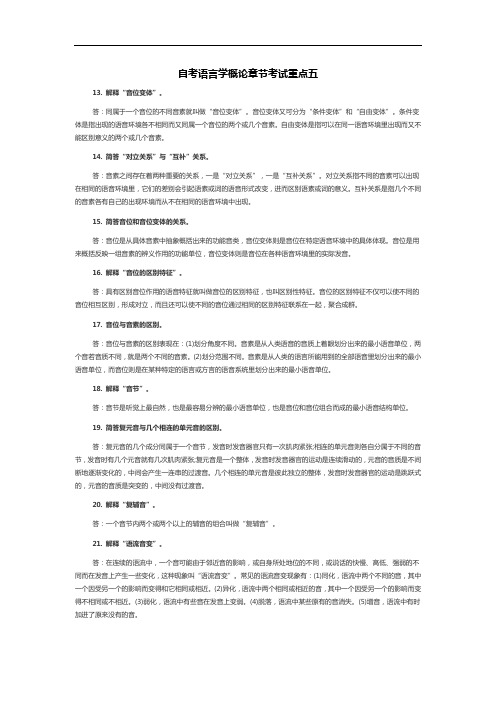
自考语言学概论章节考试重点五13. 解释“音位变体”。
答:同属于一个音位的不同音素就叫做“音位变体”。
音位变体又可分为“条件变体”和“自由变体”。
条件变体是指出现的语音环境各不相同而又同属一个音位的两个或几个音素。
自由变体是指可以在同一语音环境里出现而又不能区别意义的两个或几个音素。
14. 简答“对立关系”与“互补”关系。
答:音素之间存在着两种重要的关系,一是“对立关系”,一是“互补关系”。
对立关系指不同的音素可以出现在相同的语音环境里,它们的差别会引起语素或词的语音形式改变,进而区别语素或词的意义。
互补关系是指几个不同的音素各有自己的出现环境而从不在相同的语音环境中出现。
15. 简答音位和音位变体的关系。
答:音位是从具体音素中抽象概括出来的功能音类,音位变体则是音位在特定语音环境中的具体体现。
音位是用来概括反映一组音素的辨义作用的功能单位,音位变体则是音位在各种语音环境里的实际发音。
16. 解释“音位的区别特征”。
答:具有区别音位作用的语音特征就叫做音位的区别特征,也叫区别性特征。
音位的区别特征不仅可以使不同的音位相互区别,形成对立,而且还可以使不同的音位通过相同的区别特征联系在一起,聚合成群。
17. 音位与音素的区别。
答:音位与音素的区别表现在:(1)划分角度不同。
音素是从人类语音的音质上着眼划分出来的最小语音单位,两个音若音质不同,就是两个不同的音素。
(2)划分范围不同。
音素是从人类的语言所能用到的全部语音里划分出来的最小语音单位,而音位则是在某种特定的语言或方言的语音系统里划分出来的最小语音单位。
18. 解释“音节”。
答:音节是听觉上最自然,也是最容易分辨的最小语音单位,也是音位和音位组合而成的最小语音结构单位。
19. 简答复元音与几个相连的单元音的区别。
答:复元音的几个成分同属于一个音节,发音时发音器官只有一次肌肉紧张;相连的单元音则各自分属于不同的音节,发音时有几个元音就有几次肌肉紧张;复元音是一个整体,发音时发音器官的运动是连续滑动的,元音的音质是不间断地逐渐变化的,中间会产生一连串的过渡音。
自考语言学Chapter5
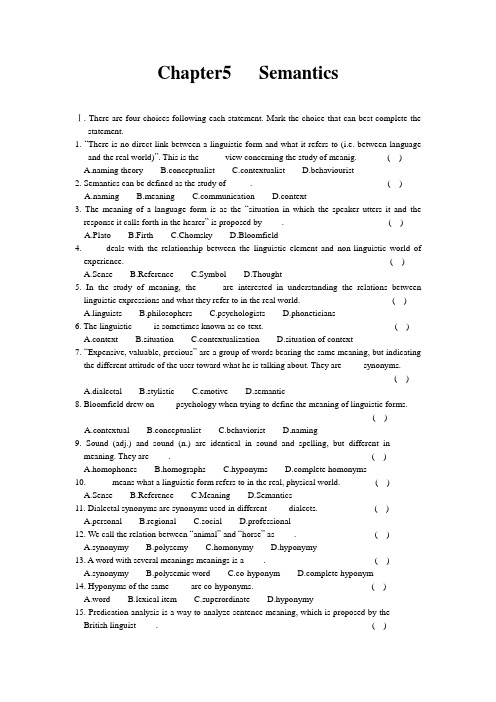
Chapter5 SemanticsⅠ. There are four choices following each statement. Mark the choice that can best complete the statement.1. “There is no direct link between a linguistic form and what it refers to (i.e. between languageand the real world)”. This is the _____ view concerning the study of meanig. ( )A.naming theoryB.conceptualistC.contextualistD.behaviourist2. Semantics can be defined as the study of _____. ( )A.namingB.meaningmunicationD.context3. The meaning of a language form is as the “situation in which the speaker utters it and the response it calls forth in the hearer” is proposed by ____. ( )A.PlatoB.FirthC.ChomskyD.Bloomfield4. ____ deals with the relationship between the linguistic element and non-linguistic world of experience. ( )A.SenseB.ReferenceC.SymbolD.Thought5. In the study of meaning, the ____ are interested in understanding the relations between linguistic expressions and what they refer to in the real world. ( )A.linguistsB.philosophersC.psychologistsD.phoneticians6. The linguistic ____ is sometimes known as co-text. ( )A.contextB.situationC.contextualizationD.situation of context7. “Expensive, valuable, precious” are a group of words bearing the same meaning, but indicating the different attitude of the user toward what he is talking about. They are ____ synonyms.( )A.dialectalB.stylisticC.emotiveD.semantic8. Bloomfield drew on ____ psychology when trying to define the meaning of linguistic forms.( )A.contextualB.conceptualistC.behavioristD.naming9. Sound (adj.) and sound (n.) are identical in sound and spelling, but different in meaning. They are ____. ( )A.homophonesB.homographsC.hyponymsplete homonyms10. _____ means what a linguistic form refers to in the real, physical world. ( )A.SenseB.ReferenceC.MeaningD.Semantics11. Dialectal synonyms are synonyms used in different ____ dialects. ( )A.personalB.regionalC.socialD.professional12. We call the relation between “animal” and “horse” as ____. ( )A.synonymyB.polysemyC.homonymyD.hyponymy13. A word with several meanings meanings is a ____. ( )A.synonymyB.polysemic wordC.co-hyponymplete hyponym14. Hyponyms of the same ____ are co-hyponyms. ( )A.wordB.lexical itemC.superordinateD.hyponymy15. Predication analysis is a way to analyze sentence meaning, which is proposed by theBritish linguist ____. ( )A.John FirthB.BloomfieldC.G.LeechD.Wittgenstein16. An ____ is a logical participant in a predication. ( )A.argumentB.predicateC.predicationD.agentⅡ. Fill in each of the following blanks with one word which begins with the letter given.1.In semantic analysis, P____ is the abstraction of the meaning of a sentence.2.S____ restrictions are constraints on what lexical items can go with what others.3.B____ , somewhat close to contextualism, is linked with psychological interest.4.E____ is a relation of inclusion.5.There are often intermediate forms between the two members of a pair of g____antonyms.6.S____ is one aspect of meaning which is the collection of all features of thelinguistic form.7.C____ synonyms are the synonyms that differ in the words they go together with.It is a matter of usage.8.The various meanings of a P____ word are related to some degree.9.Linguistic forms having the same sense may have different r____ in differentsituations.10.There is no direct link between a linguistic form and what it refers to according tothe c____ view.11.S____ synonyms are the synonyms that differ slightly in what they mean.12.In the study of meaning, p____ focus their interest on understanding the humanmind through language.Ⅲ. Decide whether each of the following statements is True or False.1. The conceptualist view can be illustrated by the semantic triangle in which thesymbol refers to the words. ( )2. The problem which the conceptualist view encounters is what is precisely the linkbetween the form and the referent. ( )3. Every utterance occurs in a particular spatiotemporal situation, the maincomponents of which are the place and time of the utterance. ( )4. The naming theory of meaning was proposed by the ancient Greek scholarPlato.( )5. “For a large class of cases...the meaning of a word is its use in the language” isproposed by Malinowski, a Polish anthropologist. ( )6. The superordinate term is more general in meaning than its hyponyms. ( )7. The Anglo-Saxon were migrants from the northern part of Europe, so the wordsthat they used and later found their way into the English vocabulary are taken as the loan words. ( )8. We often find in English pairs, or even triplets of words bearing more or less thesame meaning only for the regional reasons, e.g. girl is called lass in Scottish dialect, autumn is called fall in American English. ( )9. In componential analysis, the plus sign is used to indicate that a certain semanticfeature is present. ( )10. The first meaning of a word in the dictionary is called primary meaning.( )11. Hyponymy is a relation of inclusion, the superordinate includes all its hyponyms.( )12. The grammatical meaning of a sentence refers to its grammaticality. ( )13. The predication analysis of a sentence only applies to statements and interrogativeforms. ( )14. Linguistic forms having the same sense must have different references in the samesituation. ( )15. A sentence must have at least one argument. ( )Ⅳ. Define the following terms, giving example for illustration if necessary.1.naming theory2.conceptualist view3.behaviourism4.sense5.reference6.synonymy7.antonym8.homonymy9.homophonesplete homonyms11.hyponymy12.superordinate13.sense relations14.selectional restrictions15.predicate。
27037 本科自考英语语言学概论精心整理 Chapter 5 Morphology
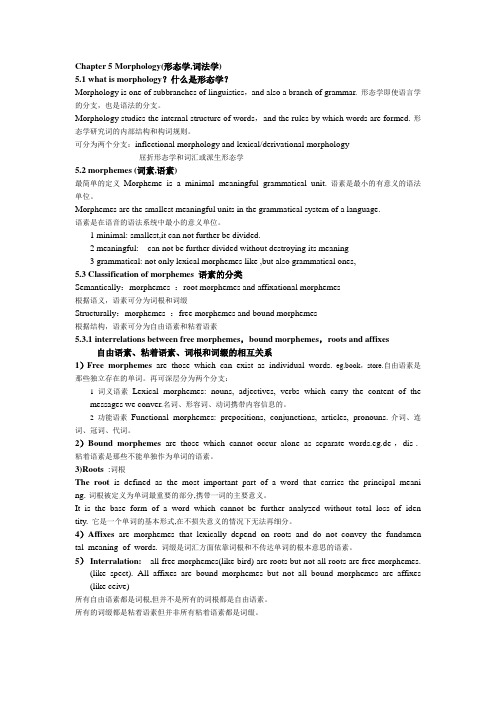
Chapter 5 Morphology(形态学,词法学)5.1 what is morphology?什么是形态学?Morphology is one of subbranches of linguistics,and also a branch of grammar.形态学即使语言学的分支,也是语法的分支。
Morphology studies the internal structure of words,and the rules by which words are formed.形态学研究词的内部结构和构词规则。
可分为两个分支:inflectional morphology and lexical/derivational morphology屈折形态学和词汇或派生形态学5.2 morphemes (词素,语素)最简单的定义Morpheme is a minimal meaningful grammatical unit.语素是最小的有意义的语法单位。
Morphemes are the smallest meaningful units in the grammatical system of a language.语素是在语音的语法系统中最小的意义单位。
1 minimal: smallest,it can not further be divided.2 meaningful: can not be further divided without destroying its meaning3 grammatical: not only lexical morphemes like ,but also grammatical ones,5.3 Classification of morphemes 语素的分类Semantically:morphemes :root morphemes and affixational morphemes根据语义,语素可分为词根和词缀Structurally:morphemes :free morphemes and bound morphemes根据结构,语素可分为自由语素和粘着语素5.3.1 interrelations between free morphemes,bound morphemes,roots and affixes自由语素、粘着语素、词根和词缀的相互关系1)Free morphemes are those which can exist as individual words.eg.book,store.自由语素是那些独立存在的单词。
自考英语语言学Chapter 5 Semantics

Chapter 5 Semantics语义学一、本章纲要二、本章重点1.What is semantics? 什么是语义学A study of meaning in language(2003填空). Linguists cannot agree among themselves as to what meaning is. Philosophers are interested in understanding the relations between linguisticexpressions and the phenomena in the real word they refer to and in evaluating the conditions of truth and falsehood of such expressions. Psychologists focus their interest on understanding the human mind through language.2.Some views concerning the study of meaning2.1 The naming theory命名论(2005单选;2007名词解释)It is one of the oldest notions concerning meaning, and also a very primitive one, proposed by Greek scholar Plato. According to his theory, the linguistic form of symbols, in other words, the words used in a language are taken to be labels of the objects they stand for. So words are just names or labels for things. 命名论是最原始的语义理论,由古希腊学者柏拉图提出。
语言学简明教程Chapter 5

1
Examples:
1) I hurried home. ( a sentence, also a clause, a simple sentence) 2) John likes linguistics, but Mary is interested in history. coordinating conjunction (coordinate sentence/compound sentence) 3) Because I was late, they went without me. subordinator subordinate clause (从属句) main clause(独立句,主句)
S NP Det A N boy V kicked VP NP Det the N ball.
14
Time for Break
15
5.3 Clause Types
Seven Clause Patterns in English
SV SVC SVA SVO SVOO SVOC SVOA
They are singing. The job is difficult. He was in the car. Lily is playing chess. I will send you the plan. The boss considers his secretary excellent. I put the plate away.
2
complex sentence
Syntax (句法)
—a branch of linguistics that studies how words are combined to form sentences and the rules that govern the formation of sentences. ( More: ….is the study of the structure of phrases, clauses and especially sentences. It is considered as a subset in the study of grammar, which includes all areas of language aspects including phonology, morphology, syntax, and semantics. Syntax studies how phrases and clauses are constructed. )
语言学概论自考复习资料第五章第四节

第四节句义 ⼀、句义的构成 1.句⼦的语⾔意义可以依据表达形式的不同⼤致分为词汇意义、关系意义和语⽓意义三个主要部分。
2.词汇意义:词是句⼦的基本构成部分,句⼦中词的意义也就成为句义的重要组成部分。
理解⼀个句⼦的意义,⾸先要懂得句中词语的词汇意义。
3.关系意义:句⼦通常都是由词语组合⽽成的,词语在组合时总要形成⼀定的结构关系,由这些结构关系所赋予的意义就是我们所说的关系意义。
词语之间的关系意义可分为语法关系意义和语义关系意义。
4.词汇意义和关系意义的区别:词汇意义是词语本⾝所具有的意义,⼀个词语即使孤⽴存在,也会具有⼀定的词汇意义,⽽关系意义则是词语进⼊组合之中才产⽣的意义,它只存在于⼀定的句法结构之中,孤⽴的词语是没有关系意义的。
5.语法关系意义:词语在⼀定的语法结构中形成的相互关系就是语法结构关系,由这种结构关系所赋予的意义就是语法关系意义。
6.语义关系意义:语义结构关系是指词语在组合中产⽣的语义上的关系,它是⼀定的现实关系的概括反映,由这种结构关系所赋予的意义就是语义关系意义。
如“猴⼦吃桃⼦”所包含的语法关系意义有“猴⼦”和“吃桃⼦”之间的“陈述”的意义和“吃”与“桃⼦”之间的“涉及”的意义,⽽这句话所包含的语义关系意义有:“吃”和“猴⼦”之间存在的“动作”和“施事”的意义和“吃”和“桃⼦”之间的“动作”和“受事”的意义。
7.语⽓意义:反映说话⼈使⽤句⼦的⽬的和说话⼈情绪的意义就是语⽓意义。
语⽓意义包括陈述、疑问、祈使、感叹等不同的意义。
在语⾔中可以通过语调、虚词和语⽓副词等形式表达。
⼆、句⼦的语义结构 1.述谓结构:由-个谓词和若⼲个变元组成,谓词是处于⽀配地位的核⼼部分。
⼀个述谓结构可以有多少变元以及有何种性质的变元,都是由谓词的语义规定的。
2.变元:⼜称题元、项等,是与谓词有直接语义关系并受谓词⽀配的语义成分,⼀般都是名词性的词语,在句⼦中经常充当主语或宾语。
3.语义⾓⾊:根据谓词和变元之间的不同语义关系,可以把变元分为若⼲类型,这种变元的类型⼀般称为语义⾓⾊。
- 1、下载文档前请自行甄别文档内容的完整性,平台不提供额外的编辑、内容补充、找答案等附加服务。
- 2、"仅部分预览"的文档,不可在线预览部分如存在完整性等问题,可反馈申请退款(可完整预览的文档不适用该条件!)。
- 3、如文档侵犯您的权益,请联系客服反馈,我们会尽快为您处理(人工客服工作时间:9:00-18:30)。
Chapter5 SemanticsⅠ. There are four choices following each statement. Mark the choice that can best complete the statement.1. “There is no direct link between a linguistic form and what it refers to (i.e. between languageand the real world)”. This is the _____ view concerning the study of meanig. ( )A.naming theoryB.conceptualistC.contextualistD.behaviourist2. Semantics can be defined as the study of _____. ( )A.namingB.meaningmunicationD.context3. The meaning of a language form is as the “situation in which the speaker utters it and the response it calls forth in the hearer” is proposed by ____. ( )A.PlatoB.FirthC.ChomskyD.Bloomfield4. ____ deals with the relationship between the linguistic element and non-linguistic world of experience. ( )A.SenseB.ReferenceC.SymbolD.Thought5. In the study of meaning, the ____ are interested in understanding the relations between linguistic expressions and what they refer to in the real world. ( )A.linguistsB.philosophersC.psychologistsD.phoneticians6. The linguistic ____ is sometimes known as co-text. ( )A.contextB.situationC.contextualizationD.situation of context7. “Expensive, valuable, precious” are a group of words bearing the same meaning, but indicating the different attitude of the user toward what he is talking about. They are ____ synonyms.( )A.dialectalB.stylisticC.emotiveD.semantic8. Bloomfield drew on ____ psychology when trying to define the meaning of linguistic forms.( )A.contextualB.conceptualistC.behavioristD.naming9. Sound (adj.) and sound (n.) are identical in sound and spelling, but different in meaning. They are ____. ( )A.homophonesB.homographsC.hyponymsplete homonyms10. _____ means what a linguistic form refers to in the real, physical world. ( )A.SenseB.ReferenceC.MeaningD.Semantics11. Dialectal synonyms are synonyms used in different ____ dialects. ( )A.personalB.regionalC.socialD.professional12. We call the relation between “animal” and “horse” as ____. ( )A.synonymyB.polysemyC.homonymyD.hyponymy13. A word with several meanings meanings is a ____. ( )A.synonymyB.polysemic wordC.co-hyponymplete hyponym14. Hyponyms of the same ____ are co-hyponyms. ( )A.wordB.lexical itemC.superordinateD.hyponymy15. Predication analysis is a way to analyze sentence meaning, which is proposed by theBritish linguist ____. ( )A.John FirthB.BloomfieldC.G.LeechD.Wittgenstein16. An ____ is a logical participant in a predication. ( )A.argumentB.predicateC.predicationD.agentⅡ. Fill in each of the following blanks with one word which begins with the letter given.1.In semantic analysis, P____ is the abstraction of the meaning of a sentence.2.S____ restrictions are constraints on what lexical items can go with what others.3.B____ , somewhat close to contextualism, is linked with psychological interest.4.E____ is a relation of inclusion.5.There are often intermediate forms between the two members of a pair of g____antonyms.6.S____ is one aspect of meaning which is the collection of all features of thelinguistic form.7.C____ synonyms are the synonyms that differ in the words they go together with.It is a matter of usage.8.The various meanings of a P____ word are related to some degree.9.Linguistic forms having the same sense may have different r____ in differentsituations.10.There is no direct link between a linguistic form and what it refers to according tothe c____ view.11.S____ synonyms are the synonyms that differ slightly in what they mean.12.In the study of meaning, p____ focus their interest on understanding the humanmind through language.Ⅲ. Decide whether each of the following statements is True or False.1. The conceptualist view can be illustrated by the semantic triangle in which thesymbol refers to the words. ( )2. The problem which the conceptualist view encounters is what is precisely the linkbetween the form and the referent. ( )3. Every utterance occurs in a particular spatiotemporal situation, the maincomponents of which are the place and time of the utterance. ( )4. The naming theory of meaning was proposed by the ancient Greek scholarPlato.( )5. “For a large class of cases...the meaning of a word is its use in the language” isproposed by Malinowski, a Polish anthropologist. ( )6. The superordinate term is more general in meaning than its hyponyms. ( )7. The Anglo-Saxon were migrants from the northern part of Europe, so the wordsthat they used and later found their way into the English vocabulary are taken as the loan words. ( )8. We often find in English pairs, or even triplets of words bearing more or less thesame meaning only for the regional reasons, e.g. girl is called lass in Scottish dialect, autumn is called fall in American English. ( )9. In componential analysis, the plus sign is used to indicate that a certain semanticfeature is present. ( )10. The first meaning of a word in the dictionary is called primary meaning.( )11. Hyponymy is a relation of inclusion, the superordinate includes all its hyponyms.( )12. The grammatical meaning of a sentence refers to its grammaticality. ( )13. The predication analysis of a sentence only applies to statements and interrogativeforms. ( )14. Linguistic forms having the same sense must have different references in the samesituation. ( )15. A sentence must have at least one argument. ( )Ⅳ. Define the following terms, giving example for illustration if necessary.1.naming theory2.conceptualist view3.behaviourism4.sense5.reference6.synonymy7.antonym8.homonymy9.homophonesplete homonyms11.hyponymy12.superordinate13.sense relations14.selectional restrictions15.predicate。
